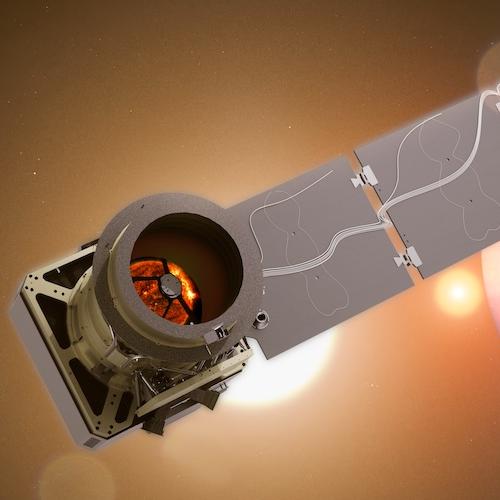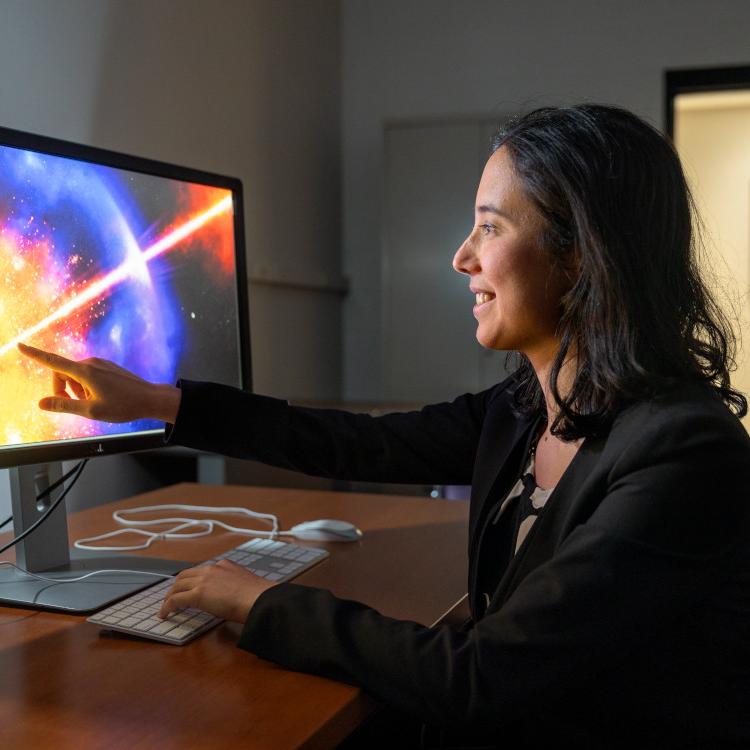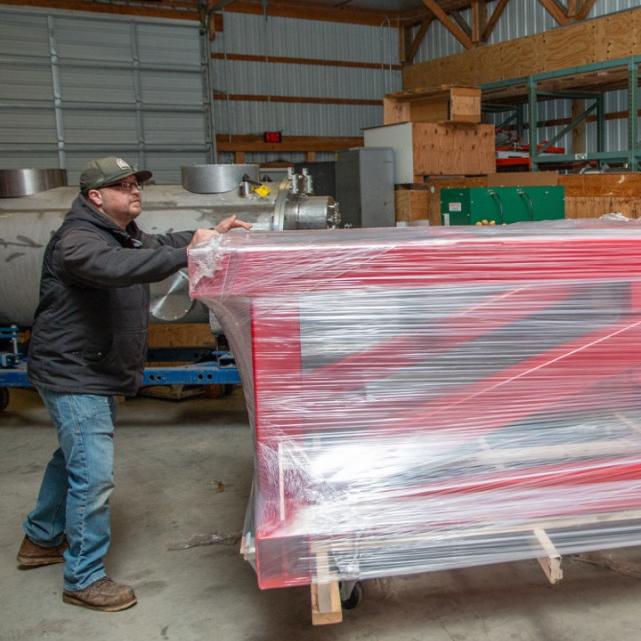The Green Bank Telescope (GBT) in West Virginia will soon see a radical transformation of its survey capabilities, thanks to a decade-long effort at Cornell to build the Advanced L-Band Phased Array Camera for Astronomy (ALPACA). Currently the GBT’s single-dish radio telescope can see only one or at most a few pixels in the sky at any given time; ALPACA will enable the GBT to observe the sky with 40 pixels simultaneously, vastly expanding what it can detect.
ALPACA will enable scientists to study a vast array of astrophysical phenomena, including the detection of Fast Radio Bursts and atomic hydrogen in the environment of galaxies; searches for extra-terrestrial intelligence, especially techno-signatures; and surveys of gas-bearing low mass dark matter haloes in the local universe. It will cover radio waves with frequencies from 1.3 to 1.7 GHz.
The instrument will also contribute significantly to pulsar research, including the discovery of new pulsars -- especially the millisecond pulsars used by the NANOGrav collaboration – an international group exploring the low-frequency gravitational wave universe – to detect nanoHz gravitational waves.
“ALPACA is actually a very different way of observing the sky,” said Amit Vishwas ’10, M.Eng.,’14, Ph.D. ’19, research scientist in the College of Arts & Sciences. “The dipoles [antennas] – all 69 of them – act as a phased array and sample the electromagnetic field in the focal plane. This information allows us to then make a beam at any point on the sky over which we have sampled the electromagnetic field.”
A new generation
While ALPACA won’t be the first radio telescope to have many pixels, it will be one of the first (if not the first) of a new generation of phased array receivers that cryogenically cool the receivers down to 20 Kelvin (minus 253 degrees Celsius or 423 degrees Fahrenheit).
“The instrument’s amplifiers also amplify noise, so cooling them decreases the noise level significantly,” said principal investigator Donald Campbell, professor emeritus of astronomy (A&S).
Unlike cryogenic “wet” systems that use liquid nitrogen or helium to cool, ALPACA will be a dry, closed system.
“Liquid helium is becoming very scarce and very valuable, so you want a system where you don't have to constantly be transferring in cryogens,” said George Gull ’72, research support specialist (A&S). “ALPACA has a compressor and three cryopumps. We use that system like a really fancy air conditioning system to cool everything down. It's a closed loop and the only thing we're using is electricity, so we're not burning off the helium supply of the world.”
All this data will come through the 69-dipole ALPACA receiver array. Dipoles are one of the simplest kinds of antenna, said Vishwas, and are used for things like car antennas. But despite a dipole’s simplicity, designing the array was not a simple task. “The dipoles have been extensively optimized for the array to work as perfectly as possible. We put a lot of work into simulations to come up with this design,” he said.
The design was complicated by the dipoles being embedded close to each other in an array so that “they all sort of talk to each other,” said Vishwas. “In order to make all of them work best together, we had to make tradeoffs against the conventional design wisdom for a single dipole.”
It will be easy to deal with any failures of the dipoles and their embedded amplifiers, said Campbell, because ALPACA is designed so that they are easy to pull out and replace.
But to enhance reliability, the dipoles also need to be protected from the intense atmospheric pressure of the cryogenic system, which requires a vacuum to operate. To this end, the dipoles sit directly beneath a white cover of extremely strong, incompressible foam that will take 200 pounds per square inch. The foam transfers the mechanical load of the atmospheric pressure to the opposite side of the structure and protects the dipoles, but is as transparent as air to radio waves.
Increasing the number of pixels means ALPACA will stream huge amounts of data that require a petabyte scale storage system – a one-day data storage would require a 700-terabyte capacity. This “running data” of what has been most recently observed will then be converted into science-ready data products, compressed (reduced in size) and then stored in an archive so it is available for scientists to analyze.
“The instrument is a very interesting amalgamation of advanced RF techniques to make this large array work and then feeding all of the signals into very advanced and powerful computing infrastructure to create the camera output,” said Vishwas. That digital back-end is being designed and built by Brigham Young University in Provo, Utah.
ALPACA’s origin story
A 7-pixel system was installed on the Arecibo radio telescope in Puerto Rico in 2004 and used for the Arecibo Legacy Fast ALFA (ALFALFA) survey led by the late Riccardo Giovanelli, emeritus professor of astronomy (A&S) and Martha Haynes, Distinguished Professor of Arts and Sciences in Astronomy (A&S). With these 7 pixels, the survey found 31,500 galaxies and provided a wealth of important scientific data. Giovanelli suggested as the next step a real phased array camera with many more pixels, preferably 40.
“As our experience with a 7 pixel radio camera on the Arecibo telescope has shown, a large aperture telescope like the GBT equipped with an even more powerful radio camera like ALPACA will make a formidable discovery machine,” said Haynes. “With 40 pixels, ALPACA will allow us to map wide areas of the sky with the GBT, promising the discovery of intriguing objects we don’t even know yet are there.”
A second 7-pixel prototype, this time with 19 dipoles, was installed on the Arecibo telescope in 2013. The “jungle” of wires the prototype required would not be feasible when scaling up, but the problem was solved by Cornell alum Chris Groppi ’97 at Arizona State University. He designed a system that simplifies things enormously by embedding eight wires at a time in flat plastic strips, said Campbell. The same system was used on a NASA balloon system that observed the sky while orbiting Antarctica and is also being used on the Prime-Cam instrument being designed by Michael Niemack, professor of physics and associate professor of astronomy (A&S), for the Fred Young Submillimeter Telescope that is being built by a Cornell-led international consortium.
The three team members have a long history with the project. Campbell began work on the project in 2010 when he was director of the Cornell-based National Astronomy and Ionosphere Center, which managed the Arecibo observatory. ALPACA was the first project Vishwas did when he started on his doctorate in 2012. Gull began working at Cornell in 1972; Campbell persuaded Gull to come out of retirement to work on ALPACA because of Gull’s extensive experience building cryogenic receiver systems.
Although ALPACA was originally intended to be installed on Arecibo, after the telescope collapsed in 2020 the team was able to adapt the instrument for the Green Bank Telescope instead.
The Green Bank Telescope is now the largest single-dish-radio telescope in the U.S. and is one of the largest moving structures on Earth. It has a 100-meter fully steerable dish, with access to 85% of the entire sky, able to point from 5 degrees above the ground to 90 degrees, and can swing a full 360 degrees. It’s located in the National Radio Quiet Preserve, which restricts what radio emissions are allowed – including no cell phones – so that the data collected has the least amount of noise possible. (For a single channel test with one dipole and amplifier, the researchers had to drive in the desert near Utah’s Great Salt Lake to escape radio noise.)
ALPACA’s future
The Cornell part of the ALPACA instrument will first be shipped to Brigham Young University for testing with the back-end digital data processor, then the entire system will be shipped to the Green Bank Observatory for testing on the ground before it is installed on the GBT to be commissioned prior to being made available to astronomers.
“From that point on, ALPACA will be a facility instrument – anyone in the world can apply to use it on the GBT,” said Vishwas.
The National Science Foundation supported the development of the ALPACA instrument and the digital back-end.
Linda B. Glaser is news and media relations manager for the College of Arts and Sciences






